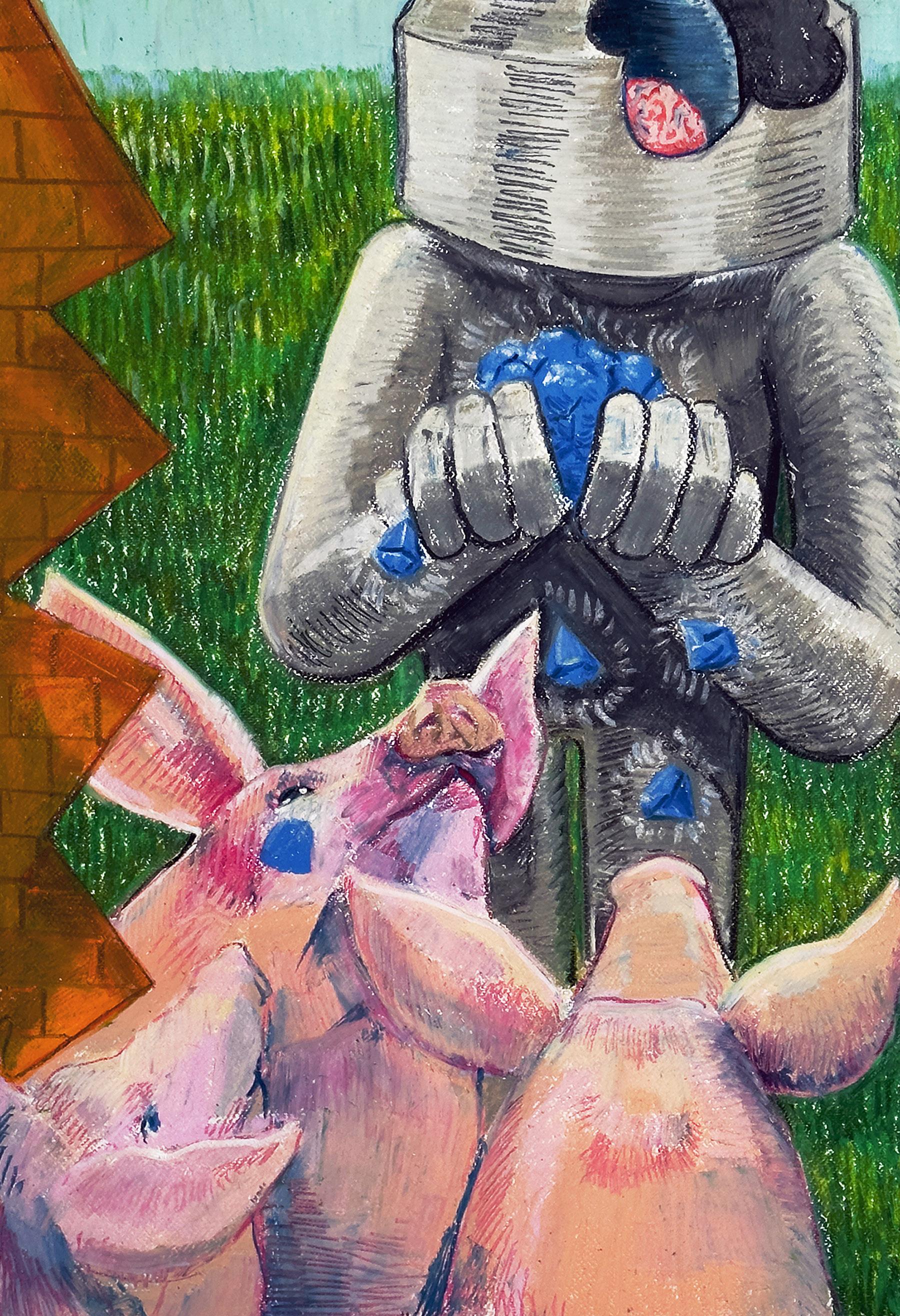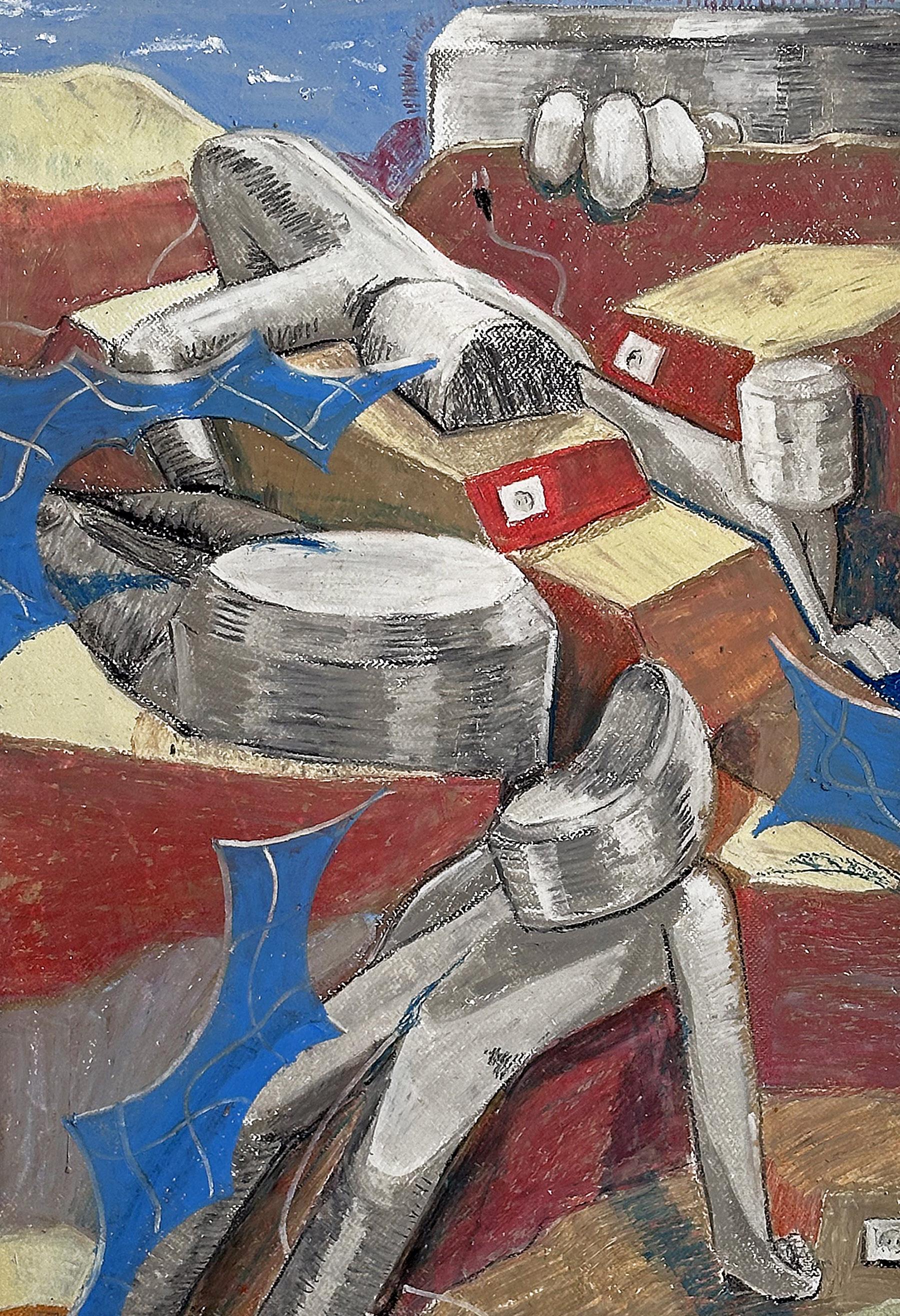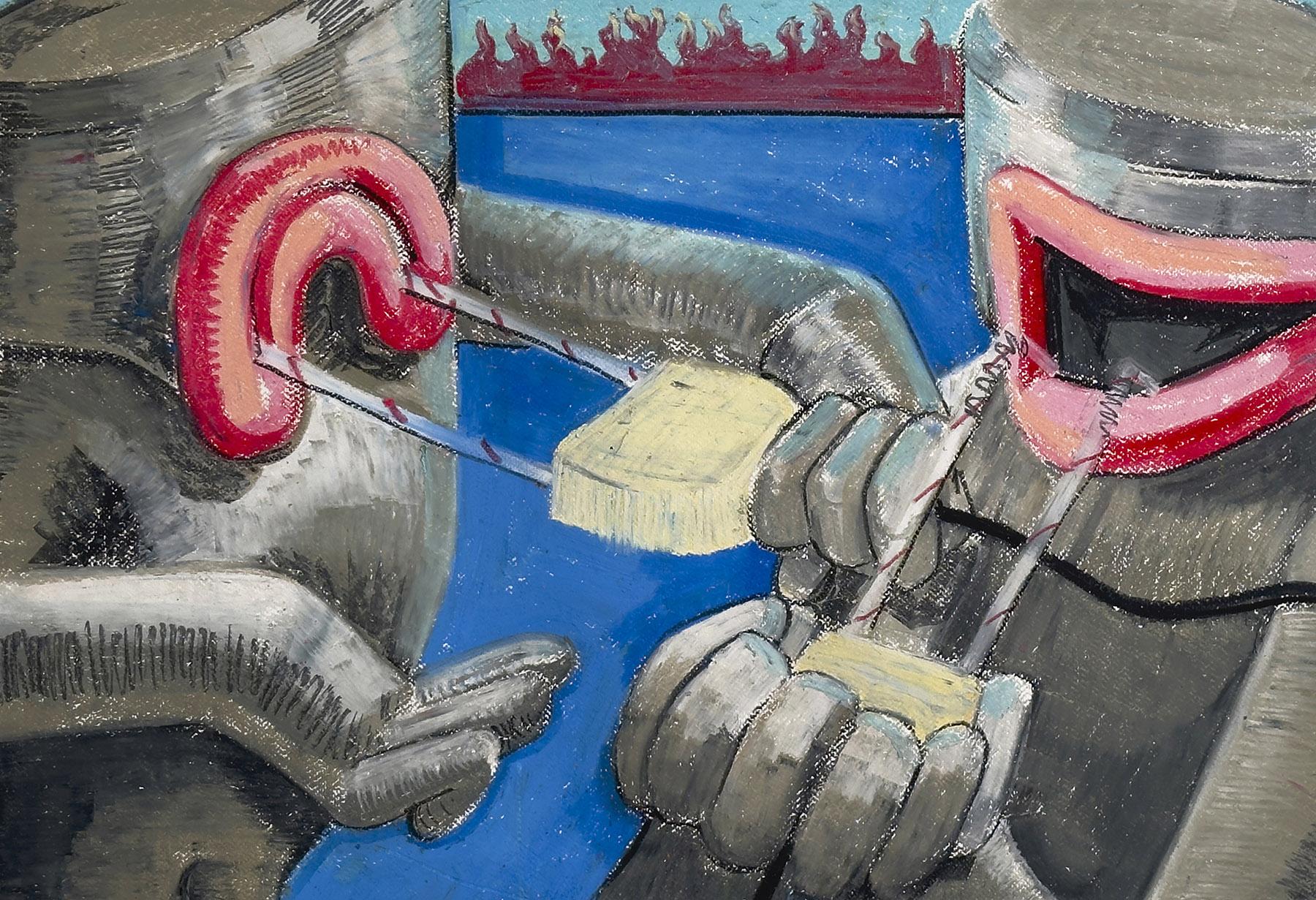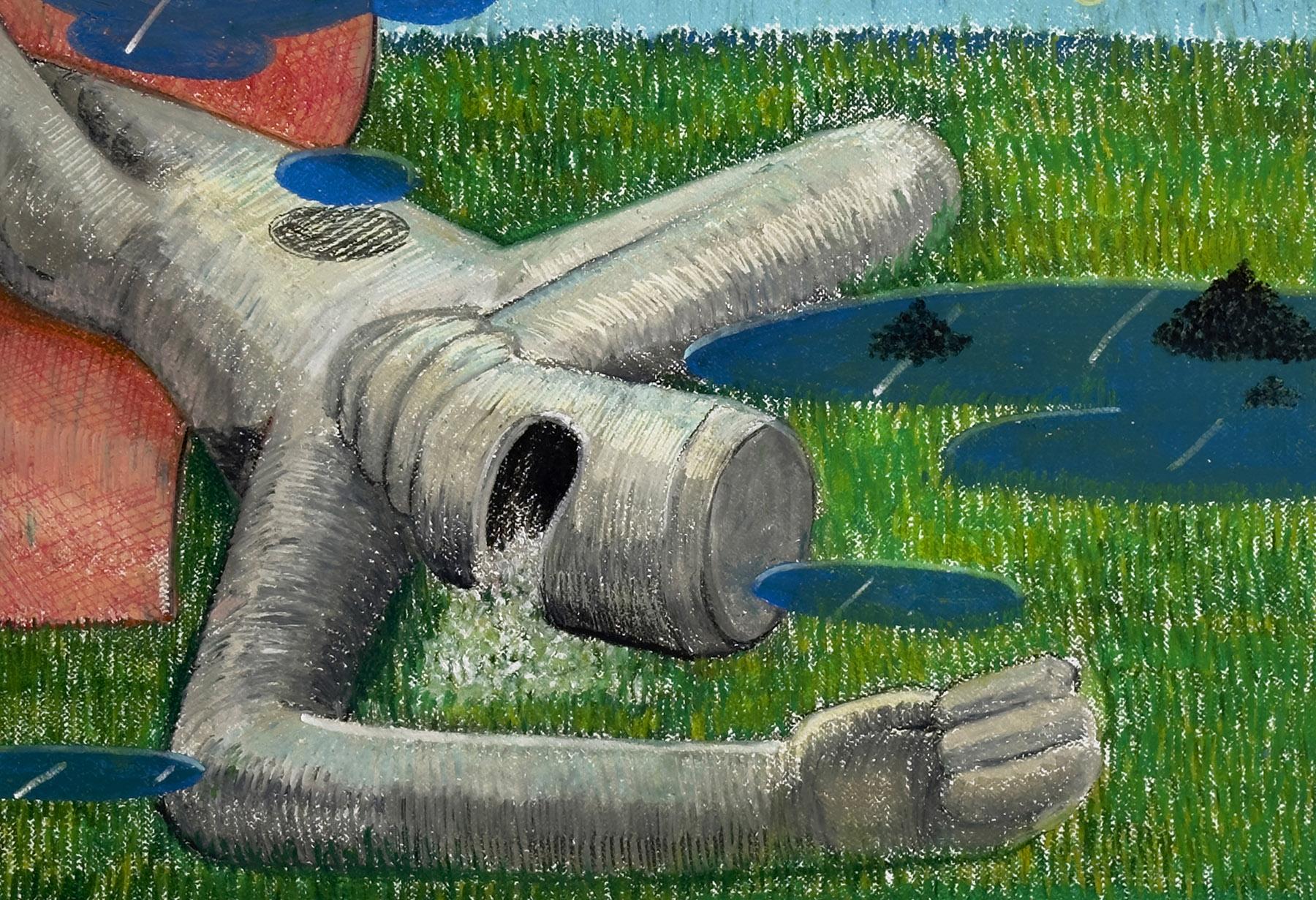Items Similar to Portrait of Guitar Player, Pastel on Paper
Want more images or videos?
Request additional images or videos from the seller
Jamie Marin-PricePortrait of Guitar Player, Pastel on Paper
About the Item
In this artwork the artist Jamie Marin-Price depicts a guitar player using vibrant colors, combined with gestural marks creating a dynamic composition.
Jamie Marin-Price, is a young American artist born in Washington, D.C. in 1970. He was educated in the Metropolitan Washington D.C. area and received his art instruction from the prestigious Corcoran School of Art. Upon graduation, Jamie's passion for art lead him to France where he entered a masters program at the University of Lille in northern France. While there, Jamie was inspired by the great abstract expressionist painter Eugene LeRoy, upon which he based his Masters thesis. As a result of his studies, Jamie has become recognized as an expert on the work of Eugene LeRoy.
Jamie received an MFA with honors and has remained in Lille, France where he lives and works as a professional artist.
Education
University of Lille, France MFA
ERSEP Ecole Rgionale Suprieur d'Expression Plastique (Fine Arts School), MFA
Corcoran School of Art, BFA
Montgomery College
Group Shows
2004 : "Les Fentres Qui Parle", Roubaix, France
2003 : "Les Fentres Qui Parle", Roubaix, France
2002 : "Drawings" Marin-Price Galleries, Washington, D.C., USA
2000 : "Drawings" Marin-Price Galleries, Washington, D.C., USA
1999 : "Drawings" Marin-Price Galleries, Washington, D.C., USA
1998 : "Le Gymnase", Roubaix, France
1997 : "Corps Accords", Eglise Marie Madeleine, Lille
1996 : "L'Intolrance", Centre Culturelle, Mricourt, France
1994 : "Des mineurs et des artistes", Centre Mmoires et Cultures, Lens, France
1993 : "Hommage Picasso", Centre Mmoires et Cultures, Lens, France
Solo Exhibitions
2005 Marin-Price Galleries, Washington, D.C., USA
2004 Marin-Price Galleries, Washington, D.C., USA
1997 Galerie de la Bourgogne, Tourcoing, France
- Creator:Jamie Marin-Price (1970 -, American)
- Dimensions:Height: 24 in (60.96 cm)Width: 18.5 in (46.99 cm)
- Medium:
- Period:
- Condition:Measurements include frame.
- Gallery Location:Surfside, FL
- Reference Number:1stDibs: LU38211374502
About the Seller
4.9
Platinum Seller
These expertly vetted sellers are 1stDibs' most experienced sellers and are rated highest by our customers.
Established in 1995
1stDibs seller since 2014
1,549 sales on 1stDibs
Typical response time: 1 hour
- ShippingRetrieving quote...Ships From: Surfside, FL
- Return PolicyA return for this item may be initiated within 3 days of delivery.
More From This SellerView All
- Cuban Artist Pastel Drawing African American Emilio Cruz Bonnie & Clyde PaintingLocated in Surfside, FLEmilio Cruz (1938-2004) Bonnie and Clyde Pastel on paper Hand signed lower right Dimensions Framed H 15-7/8" W 18-1/2", Sight H 13-1/2" W 16-1/8" Emilio Antonio Cruz (1938 – 2004) was a Cuban American artist who lived most of his life in New York City. His work is held in several major museums in the United States. Emilio Antonio Cruz was an American Artist of Cuban descent. He was born in the Bronx on March 15, 1938. He studied at the Art Students League of New York with Edwin Dickinson, George Grosz and Frank J. Reilly and at The New School in New York City, and finally at the Seong Moy School of Painting and Graphic Arts in Provincetown, Massachusetts. As a young artist in the 1960s, Cruz was connected with other artists who were applying abstract expressionism concepts to figurative art such as Lester Johnson, Red Grooms, Mimi Gross, Bob Thompson and Jan Muller. He combined human and animal figures with imagery from archaeology and natural history to create disturbing, dreamlike paintings. Cruz received a John Hay Whitney Fellowship and awards from the Joan Mitchell Foundation and from the National Endowment for the Arts. In the late 1968, Emilio and wife Patricia Cruz moved to St. Louis to work with Julius Hemphill and the Black Artists Group. He served as director for the visual arts program, which also included painters Oliver Jackson and Manuel Hughes. In addition to artistic contributions, the couple participated in city-wide civil rights protests and rent strikes. Cruz moved to Chicago and taught at the School of the Art Institute of Chicago during the 1970s, where he exhibited widely and was represented by the Walter Kelly Gallery. He wrote two plays, Homeostasis: Once More the Scorpion and The Absence Held Fast to Its Presence. These were first performed at the Open Eye Theater in New York in 1981, and later were included in the World Theater Festival in Nancy and Paris, France, and in Italy. In 1982 he returned to New York where he began to exhibit again. In the late 1980s he resumed teaching at the Pratt Institute and at New York University. Harry Rand, Curator of 20th Century Painting and Sculpture at the Smithsonian American Art Museum, described Emilio Cruz as one of the important pioneers of American Modernism of the 1960s for his fusion of Abstract Expressionist art with figuration. Geno Rodriguez, Curator and Executive Director of The Alternative Museum, wrote in 1985, "Emilio Cruz, is a brilliant and impassioned artist whose current paintings are monumental, imbued with intelligence, fury and an apt sense of irony. They reflect the turbulent world within which we live." Geoffrey Jacques wrote in 1990, "Emilio Cruz paints humanity’s essence. Mythology and archeology are the foremost concerns of the painter Emilio Cruz. Dinosaurs, skeletal humans and fossil-like images are used in his work as metaphoric signposts in a consideration of the basic questions of existence." Art historian and curator Paul Staiti wrote in 1997, "Emilio Cruz's Homo sapiens series is a strange and haunting genealogy of the modern soul... What is at stake here more than biopolitical culture, is the remystification of the body and mapping of consciousness ... For all the trauma, explicit and implicit, Cruz's style is masterful, classical, even beautiful." Exhibitions Cruz held his first solo exhibition at the Zabriskie Gallery in New York in 1963. Afterwards his work was included in many group and solo exhibitions, including the Anita Shapolsky Gallery in 1986 and 1991, museum exhibitions at the Studio Museum in Harlem in 1987, the Pennsylvania Academy of the Fine Arts in 1997. In 1994, Cruz's work was shown as part of the American contingent at the IV Bienal Internacional de Pintura en Cuenca, Ecuador. Other American artists exhibiting at this show were Donald Locke...Category
20th Century Neo-Expressionist Figurative Drawings and Watercolors
MaterialsPaper, Oil Pastel
- Abstract Expressionist Gestural Oil Pastel Drawing Women Figures Anthony TrianoLocated in Surfside, FLAnthony Thomas Triano (1928–1997) was an abstract expressionist painter, sculptor, illustrator and teacher. His works feature natural forms, especially the human form, and tend towar...Category
1960s Abstract Expressionist Abstract Drawings and Watercolors
MaterialsPaper, Oil Pastel
- The Mean Hippies (Drawing with Rattlesnake Warrior and Red Rebels) Outsider ArtBy Alex O'NealLocated in Surfside, FLPaper measures 21 X 33 inches Born and raised in Mississippi, Alex O'Neal graduated from Rhode Island School of Design and School of the Art Institute of Chicago. In the Eighties, his formal education overlapped regular visits with Mississippi self-taught artists, including Mary T. Smith, Luster Willis, and Son Ford Thomas. He later immersed himself in art brut collections and European art brut in Switzerland, Germany, and France. His work is also inspired by African-American self-taught outsider art. O'Neal's drawings and paintings have been shown at The Drawing Center, New York; BRIC, Brooklyn; P.S.122, New York; Johnson Museum of Art, Ithaca, NY; Woodruff Arts Center, Atlanta; Tennessee Arts Commission, Nashville; Mississippi Museum of Art, Jackson, MS; Centre d’Art des Pénitents Noirs, Aubagne, France; Contemporary Arts Center, New Orleans; Chicago Cultural Center; Ecomuseu, Valls d'Aneu, Spain; Amory Arts Center, West Palm Beach; Huntsville Museum of Art, AL; Rockefeller Art Center, SUNY Fredonia; ART LA; Field Projects, New York; LOG at Lump Gallery, Raleigh, NC; and Linda Warren Projects, Chicago. His work is in volumes 16, 38, and 104 of New American Paintings. His paintings and drawings idiosyncratically depict circumstances that associate Americans, i.e. dysfunction, nature worship, cults, homegrown terrorism, Hollywood, reverence for Native America. There is formal influence from stylization found in Romanesque fresco, early American portrait painting...Category
21st Century and Contemporary Outsider Art Figurative Paintings
MaterialsOil Pastel, Archival Paper
- One More Time (Black Devil) Outsider Art Painting, DrawingBy Peter DeanLocated in Surfside, FLDean was born in 1934 of Jewish parents in a Berlin, Germany, that was falling prey to the Nazis. The family immigrated to New York City in 1938, and Dean was raised in the refugee community in Inwood. Dean's first show (ironically, in retrospect) was given him by the USIA in Brazil. In 1959, he returned to New York to work six months on, six months off in soil engineering and made art in the interims. He tried, and failed, to get into a Tenth Street Gallery. Studying painting at night with Andre Girard at City College pushed him over the edge, and in 1969 he committed himself to painting full time. Artists who impressed him in the '60s were Robert Beauchamp, Lester Johnson, Jan Muller...Category
1980s Expressionist Figurative Drawings and Watercolors
MaterialsPaper, Oil Pastel, Acrylic
- 1945 Pastel Drawing Girl with Flower American ModernistBy Frank KleinholzLocated in Surfside, FLBorn in Brooklyn, New York, Frank Kleinholz was a painter based in New York City whose work spanned several art movements including Expressionism and Social Realism. His early works ...Category
1940s American Modern Figurative Drawings and Watercolors
MaterialsPaper, Oil Pastel
- Untitled, Horse and Wagon Pastel Drawing Shtetl Judaica Scene Polish Jewish LifeBy Simon Natan KarczmarLocated in Surfside, FLSimon Karczmar, Polish (1903 - 1982) Born in Warsaw, Poland, in 1903, Simon Karczmar studied art in Paris, where he lived for twenty years. Although he left France for Israel in 1962, most of his work evokes his experiences in Eastern Europe. Immigrated to Israel 1962 and joined Artists' Quarter in Safed. Represented Israel at exhibitions in Mexico, Canada, U.S.A. and Europe. In this series of images known collectively as Shtetl, Karczmar draws inspiration from his childhood memories of the vacations he spent at his grandfather's house in Lithuania. The word shtetl is Yiddish for little town and refers to the villages with significant Jewish populations that could once be found throughout Eastern Europe. The nostalgia of Karczmar's renderings contrasts with the darker views of life for Jews revealed in the photographs by Roman Vishniac and drawings of Ephraim Moshe Lilien...Category
Late 20th Century Modern Figurative Drawings and Watercolors
MaterialsOil Pastel, Mixed Media
You May Also Like
- La femme préhistorique (Prehistoric Woman)By James Jacques Joseph TissotLocated in New Orleans, LAJames Tissot was among the most successful and critically acclaimed artists of the Victorian era. Although the artist is celebrated for his elegant scenes of fashionable life in Paris and London, this work is a fascinating rarity within his oeuvre. In this monumental pastel, Tissot depicts a prehistoric woman draped in a tiger skin, presented with a striking pose and heroic air. His delicate portraiture, combined with his fascination with conveying texture, demonstrates why he was one of the most revered artists of his generation, and La femme préhistorique illustrates the remarkable technique for which he was renowned. This work was completed in preparation for a series of works exploring the Old Testament undertaken by Tissot from 1899-1902 that remained unfinished at the time of his death. A portion of this series focused on illustrations of Adam and Eve, and among these sketches were images of a nude Eve partially draped in animal furs. Towards the end of his life, following his conversion to Catholicism, biblical subjects became important to the artist. A few years before this work was completed, Tissot embarked upon a highly ambitious group of nearly 300 watercolors illustrating the New Testament, presenting the illustrated epic in its entirety at the Paris Salon of 1894. Both of these series were a critical artistic departure for the artist, stemming from a desire to create works separated from his typical images of modern society. This pastel imagines Eve as the prototype of womanhood in the guise of a prehistoric woman. Tissot rarely painted the nude, and his skill as a draftsman highlights the figure's natural beauty, contrasting it with the stark landscape surrounding her. Although a study, this monumental work is incredibly well-finished and highly engaging, with the statuesque model commanding the majority of the canvas. Her pose is strong and theatrical, and she addresses the viewer with a direct, confident gaze. The imagined historical subject of this drawing is grounded by Tissot’s exceptional attention to detail. A master of conjuring an array of textures, Tissot showcased this ability in this work by juxtaposing many types of fabrics and natural elements within one composition. The tiger skin with which the woman partially covers herself was a favorite studio prop of Tissot’s, appearing in many of his most influential works from the period, including several paintings of his partner and favorite model Kathleen Newton. It, in particular, showcases the artist’s understanding of texture, yet it also serves as an exotic element that elevates the sensuality of the scene when placed against the woman’s bare skin. Born in 1836 in the port town of Nantes, Tissot traveled to Paris at the age of 20 in order to join the studios of Hippolyte Flandrin and Louis Lamothe. During this period, he became close with James Abbott McNeill Whistler, Edgar Degas and Edouard Manet, and the impact of these friendships is reflected in his portraits of modern life. Having enjoyed considerable success in Paris during the 1860s, Tissot fought in the Siege of Paris, and after the fall of the Commune in 1871, he went to London, where he stayed for the next ten years. He was met with incredible success there, and he also met the love of his life, Kathleen Newton, a divorcée, with whom he lived from about 1876 until her death in 1882. Today he is regarded among the great masters of Belle Époque painting, and his works can be found in important collections worldwide, including the Metropolitan Museum of Art, the Brooklyn Museum, the National Gallery of Art, the Musée d’Orsay, the Tate Gallery and many others. This pastel remained in Tissot's private collection until his death in 1902 and is referenced in the posthumous 1902-3 valuation of Tissot's home at 64 avenue du Bois...Category
Early 20th Century Academic Nude Drawings and Watercolors
MaterialsLaid Paper, Canvas, Oil Pastel, Pastel
- Pigs love diamondsBy João CardosoLocated in MADRID, ESOil pastel on 350 g/m2 textured paper. With thoughts on 21st century humans and their future, João Cardoso concludes that technology brings tools for two extremes. Thus, technology,...Category
21st Century and Contemporary Contemporary Figurative Drawings and Water...
MaterialsOil Pastel
- Sun bathing on the rocksBy João CardosoLocated in MADRID, ESOil pastel on 350 g/m2 textured paper. With thoughts on 21st century humans and their future, João Cardoso concludes that technology brings tools for two extremes. Thus, technology,...Category
21st Century and Contemporary Contemporary Figurative Drawings and Water...
MaterialsOil Pastel
- Untitled IIBy João CardosoLocated in MADRID, ESOil pastel on 350 g/m2 textured paper. With thoughts on 21st century humans and their future, João Cardoso concludes that technology brings tools for two extremes. Thus, technology,...Category
21st Century and Contemporary Contemporary Figurative Drawings and Water...
MaterialsOil Pastel
- ThirstyBy João CardosoLocated in MADRID, ESOil pastel on 350 g/m2 textured paper. With thoughts on 21st century humans and their future, João Cardoso concludes that technology brings tools for two extremes. Thus, technology,...Category
21st Century and Contemporary Contemporary Figurative Drawings and Water...
MaterialsOil Pastel
- Sugar is now more deadly than gun powderBy João CardosoLocated in MADRID, ESOil pastel on 350 g/m2 textured paper. With thoughts on 21st century humans and their future, João Cardoso concludes that technology brings tools for two extremes. Thus, technology,...Category
21st Century and Contemporary Contemporary Figurative Drawings and Water...
MaterialsOil Pastel





